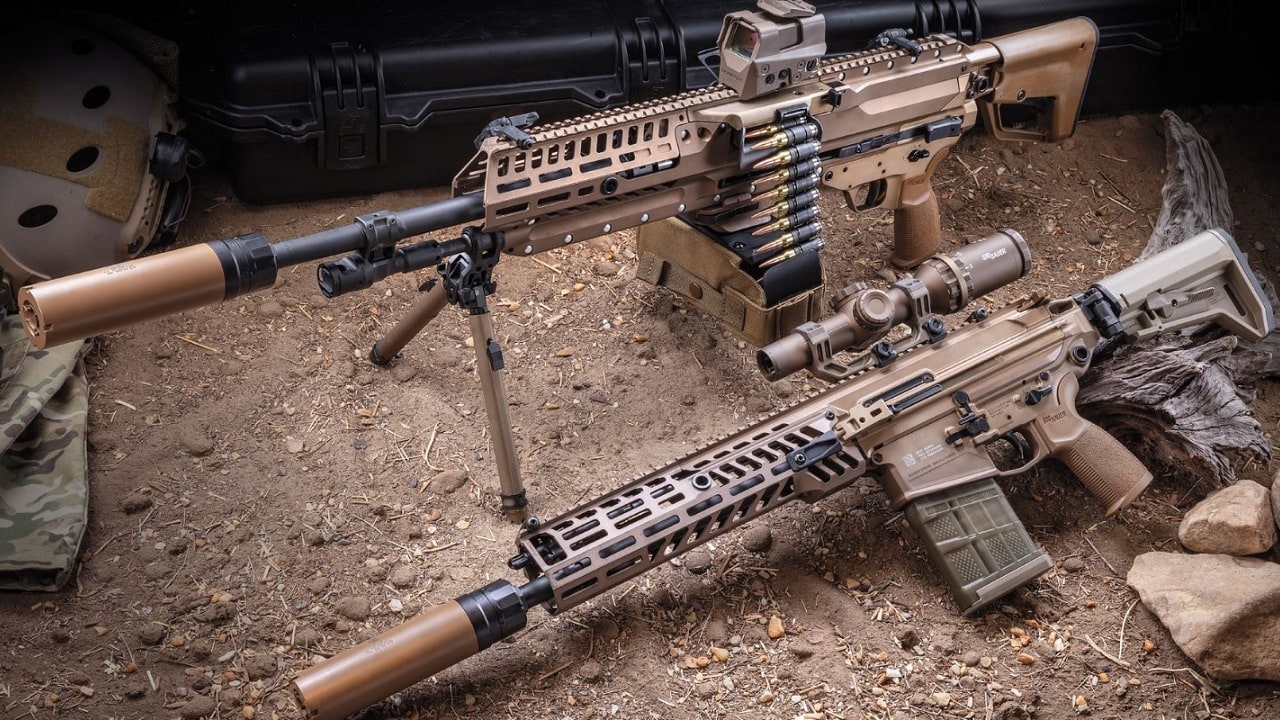Our in-house U.S. Army expert (who served in the U.S. Army) gives us his take on the M250: I have been advocating for U.S. Army infantry units to move away from the M4 carbine or at least supplement the platoon with a longer-range, longer-barrel, bigger caliber, higher-muzzle velocity rifle since 2007. It looks like the Army is finally listening as it will field the Next-Generation Squad Weapon (NGSW), designated the M5, in 2023. The NGSW program will also replace the M249 squad automatic weapon, known as the SAW, with a new model called the M250.
New Round Should Be More Powerful and Enable Longer Range
These new weapons will fire a larger caliber round. No more weaker 5.56mm NATO chambered weapons. The M5 and M250 will shoot the more powerful 6.8mm. Soldiers have been complaining about the 5.56mm since Vietnam because it has less stopping power compared to the 7.62mm. Some troops in Iraq and Afghanistan believed that the M4 firing its 5.56mm round would lose its effectiveness past 300 meters.
Are These the Weapons to Take On Russia and China?
The Army also thinks that in a potential war with Russia or China, the enemy soldiers would have more effective body armor that could resist the 5.56mm. A report called the Small Arms Ammunition Configuration Study several years ago concluded that the Army needed to use a middle ground caliber between the 5.56mm and the 7.62mm. This is the biggest change in Army rifles since 1964 when the M16 began to be adopted.
Fat Contract for Sig Sauer
Sig Sauer received the bid for the NGSW in a contract worth $4.7 billion. Sig will also have a contract for the NGSW fire control systems for $2.7 billion.
Forward-deployed Troops Get First Crack At It
Not all personnel will be using the M5 and M250 next year. It will first go to Army Special Forces and Rangers, the Infantry, Cavalry Scouts, and Combat Engineers. Non-combat rear-echelon soldiers will still be outfitted with the M4.
M4 Not Up to Snuff
I have long criticized the M4 for its shorter range, less penetrating power, small size, and its low muzzle velocity. Having enlisted in the Army in 1999, I was still using the M16A2, and was very satisfied with its performance. In 2002, as an Infantry officer, I switched over to the M4 and was uncomfortable firing it and I knew the Army needed a rifle that had longer range with a more powerful round.
But the M4 Had Its Advantages
The M4, with its collapsible stock, was originally preferred by airborne personnel who liked the smaller size while parachuting. It then spread to the Infantry and other soldiers. I admit the weapon is better in close combat situations, especially for clearing houses and buildings. A longer barrel rifle is more difficult to control in tighter spaces. The rail system was great for placing close combat optics and other accessories. But the M5 and M250 will keep the Picatinny rail. The M5 will also maintain the popular collapsible butt stock. The new rifle will have an ambidextrous safety and a charging handle option for left-handed shooters.
Testers Have Reportedly Giving NGSW Good Reviews
Brigadier General Christopher Schneider, director of Program Executive Office-Soldier, told Army Times that testers only shoot the M5 and M250 a short time and prefer its ergonomics and feel. This leads them to be proficient “in minutes,” Schneider said.
The new optics on the M5 and M250 will have a laser range finder and a ballistic computer for aim correction.
Generation Z Gets to Have All the Fun
I am excited for this generation of soldiers who will get to fire and adopt the M5 and M250. I would love to be able to shoot those rifles and who knows, there may be a commercial version of the M5 from Sig Sauer and copycat manufacturers who would make the rifle or variants available to civilians.
It’s good the Army has listened to criticism and has moved on from the M4 and the SAW. I think it took too long, but the service branch didn’t want to switch to a new rifle in the middle of a war, which is what happened to the M16 during Vietnam. The transition was rocky in the 1960s. Let’s see if the soldiers prefer using the M5 and M250 and they get good reviews in the coming years.
Expert Biography: Serving as 1945’s Defense and National Security Editor, Dr. Brent M. Eastwood is the author of Humans, Machines, and Data: Future Trends in Warfare. He is an Emerging Threats expert and former U.S. Army Infantry officer. You can follow him on Twitter @BMEastwood. He holds a Ph.D. in Political Science and Foreign Policy/ International Relations.

